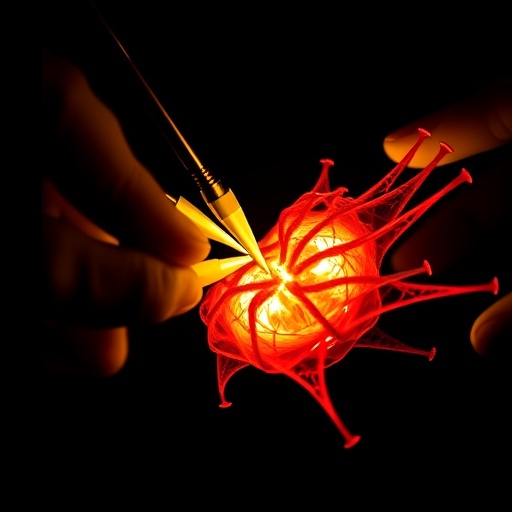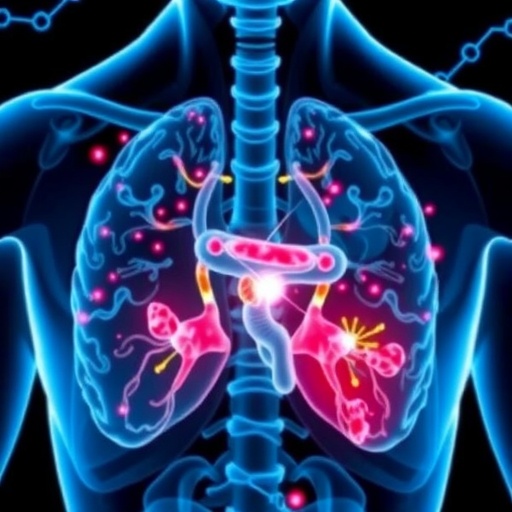
A groundbreaking surgical technique developed by scientists at the National Institutes of Health (NIH) promises to advance the treatment landscape for dry age-related macular degeneration (AMD), one of the most common causes of vision loss in older adults. This novel approach enables the implantation of multiple tissue grafts into the retina, a feat previously unattainable with conventional methods, which allowed placement of only a single graft. Published recently in the high-impact journal JCI Insight, these findings mark a significant step forward in regenerative ophthalmology and offer renewed hope for millions affected by degenerative retinal diseases.
Dry AMD results from the gradual deterioration of the retina’s light-sensitive tissue located at the back of the eye, severely impairing central vision. The retina’s complex architecture includes photoreceptors and the retinal pigment epithelium (RPE), a layer critical for supporting photoreceptor survival and function. In this condition, the loss of RPE cells invariably leads to the death of photoreceptors, culminating in irreversible vision impairment. While laboratory research has demonstrated that grafts composed of patient-derived stem cell-derived RPE can potentially restore retinal function, surgical limitations have historically prevented the placement of more than one graft, reducing the scope of treatment and complicating preclinical evaluations.
Responding to these challenges, the NIH research team engineered an innovative surgical clamp specifically designed to maintain intraocular pressure while enabling sequential implantation of two tissue patches with minimal collateral damage to surrounding retinal tissue. This precision instrument preserves the delicate retinal environment during the insertion process, which is essential for the successful integration of transplanted material. By enabling multiple graft placements within the same animal model lesion, this technology offers unprecedented opportunities to conduct direct, side-by-side assessments of graft efficacy and integration, thereby accelerating the path from bench to bedside.
The team put their new surgical technique to the test using a well-established pig model that recapitulates the pathological features of dry AMD. In these experiments, two types of grafts were transplanted sequentially into the same degenerative retinal area: a patch of RPE cells cultured from human blood-derived induced pluripotent stem cells (iPSCs) grown on a biodegradable scaffold, and a scaffold-only graft serving as a critical control. Human iPSC-derived RPE cells provide a renewable and patient-specific source of retinal cells capable of supporting damaged photoreceptors, a revolutionary approach compared to previous transplantation strategies.
Postoperative evaluation employed cutting-edge artificial intelligence algorithms to analyze retinal images in great detail, offering quantitative insight into graft performance. This sophisticated image analysis revealed a marked survival advantage for photoreceptors situated near the RPE graft, whereas those adjacent to scaffold-only grafts experienced significant degeneration and cell death. These results demonstrate not only the graft’s ability to preserve retinal neurons but also its critical role in maintaining retinal function, validating the therapeutic potential of patient-derived RPE patches in retinal repair strategies.
Intriguingly, the research uncovered for the first time that the RPE graft also contributed to the regeneration of the choriocapillaris, a thin network of capillaries beneath the retina responsible for delivering oxygen and nutrients essential to photoreceptor health. Choriocapillaris degeneration is widely recognized as a contributing factor to AMD progression; thus, this finding suggests that RPE transplantation might confer dual benefits by restoring both retinal cells and their vital vascular support. This vascular regeneration component could have profound implications for long-term graft survival and functional recovery.
This innovative approach dovetails seamlessly with an ongoing first-in-human clinical trial, also led by NIH investigators, evaluating autologous iPSC-RPE grafts in patients with the dry form of AMD. The current animal model findings provide crucial preclinical evidence supporting the safety and efficacy of implanting multiple grafts, thereby enhancing potential therapeutic outcomes by treating larger retinal areas affected by degeneration. Such advancements are pivotal for diseases like AMD, where widespread retinal damage demands comprehensive intervention.
Developing surgical tools that maintain stable intraocular pressure during delicate manipulations represents a significant advancement in ophthalmic surgery. Elevated or fluctuating eye pressures during procedures can cause retinal detachment or damage, undermining graft success. The team’s novel clamp overcomes these risks, ensuring safe, efficient, and reproducible implantation outcomes. This mechanical innovation may extend beyond AMD therapy, opening avenues for broader applications in ocular tissue engineering and transplantation.
The use of patient-derived induced pluripotent stem cells to culture retinal cells brings a personalized medicine dimension to treating degenerative eye diseases. These cells circumvent ethical and immunological barriers posed by allogeneic transplants and enable the production of retinal cells that match the patient’s genomic background, potentially improving graft tolerance and reducing rejection. Combined with the new surgical approach, this stem cell technology embodies the cutting edge of translational ophthalmic research.
Additionally, the integration of advanced artificial intelligence in postoperative assessments introduces an objective, high-throughput method for evaluating tissue grafts. Computer vision and machine learning models can detect subtle changes in retinal structure and cell viability that might be missed by traditional manual analysis. Such digital biomarker quantification enhances the rigor and reproducibility of preclinical studies, accelerating the feedback loop between experimental innovation and therapeutic refinement.
This pioneering work was supported by the Intramural Research Program of the National Eye Institute (NEI), part of NIH, which has long been at the forefront of vision science research. The multi-disciplinary collaboration among bioengineers, stem cell biologists, and ophthalmic surgeons underscores the complex, integrative efforts required to tackle challenging diseases like AMD. The new surgical clamp and accompanying findings represent a model of how combining engineering, biology, and medicine can generate transformative health advances.
Looking forward, broad clinical adoption of this multi-graft implantation technique will depend on further refinement of graft preparation, surgical procedures, and long-term outcomes monitoring. Nonetheless, this research sets a new standard for retinal regenerative therapies and offers a template for future interventions targeting other forms of vision loss. By restoring both retinal cells and their vascular support, the therapy promises to preserve sight and improve quality of life for millions living with AMD-related blindness.
As the global burden of age-related vision loss continues to rise with aging populations, innovations like this exemplify how cutting-edge scientific research translates into tangible clinical benefits. Through the convergence of stem cell biology, surgical ingenuity, and machine learning analytics, NIH researchers are charting a transformative course toward restoring vision and combating previously irreversible diseases.
Subject of Research: Innovative surgical technique for sequential implantation of multiple retinal tissue grafts to treat dry age-related macular degeneration using patient-derived iPSC-RPE patches.
Article Title: iPSC-RPE patch preserves photoreceptors and regenerates choriocapillaris in a pig outer regina degeneration model
News Publication Date: 22-May-2025
Web References:
Article DOI: 10.1172/jci.insight.179246
NIH First-in-Human Clinical Trial News: https://www.nih.gov/news-events/news-releases/first-us-patient-receives-autologous-stem-cell-therapy-treat-dry-amd
NEI Website: https://www.nei.nih.gov/
NIH Website: https://www.nih.gov/
References:
Gupta R, Bunea I, Alvisio B, Barone F, Gupta R, Baker D, Qian H, Daniele E, Contreary CG, Montford J, Sharma R, Maminishkis A, Singh MS, De Quadros Costa MTM, Kashani AH, Amaral J, Bharti K. “iPSC-RPE patch preserves photoreceptors and regenerates choriocapillaris in a pig outer regina degeneration model”. JCI Insight. Published May 22, 2025.
Sharma R, et al. Clinical-grade stem cell–derived retinal pigment epithelium patch rescues retinal degeneration in rodents and pigs. Sci. Transl. Med. (2019). DOI: 10.1126/scitranslmed.aat5580
Keywords:
Health and medicine; Eye diseases; Macular degeneration; Surgery; Retina; Photoreceptors
Tags: AMD surgical interventionsanimal models in AMD researchcentral vision impairment solutionsnew approaches in degenerative retinal diseasesNIH surgical technique for dry AMDphotoreceptor survival supportregenerative ophthalmology advancementsretinal disease regenerative strategiesretinal pigment epithelium restorationstem cell-derived RPE therapytissue graft implantation in retinavision loss treatment innovations





